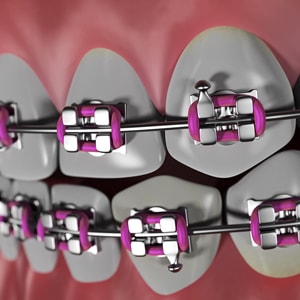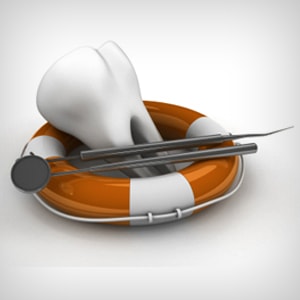Restorative care El Paso TX
Why Restore Baby Teeth?
A common question asked of the dentist is: Why do we have to fix the baby teeth? They are going to fall out anyway. There are a number of reasons baby teeth are important and should be maintained properly.
1. These are the only teeth the child has at this point in life. Even though baby teeth are thought to be only "temporary" teeth, this temporary time period spans over the first 12 years of the child’s life. From the time the first tooth erupts into the mouth (usually around 6 months of age) until the last baby tooth is lost (usually around 12 years of age), the child has baby teeth in the mouth (either all baby teeth or a combination of baby teeth and permanent teeth). The baby teeth are as important to the child at this time as the permanent teeth are to you and me. The anatomy of the baby teeth is similar to the permanent teeth and is just as susceptible to the decay process. Once the decay process has invaded the nerve chamber, the tooth may become abscessed, which results in pain and swelling. If left untreated, an abscessed baby tooth can become a life-threatening situation requiring hospitalization of the child.
2. They allow the child to eat properly. This is probably an obvious statement. The child with healthy baby teeth is able to eat properly due to the fact that they are pain-free and the teeth are present to aid chewing.
3. Baby teeth are designed to be natural space maintainers. The baby teeth serve as guides for the permanent teeth to erupt into normal position. When baby teeth are lost prematurely or severely broken down due to dental decay, abnormal shifting can occur prior to the permanent tooth erupting into the mouth. This can cause abnormal eruption, crowding and impaction of the permanent teeth, which can in turn lead to complicated orthodontic problems in the future.
As you can see, although baby teeth are eventually lost, they play an important role while they are in the mouth. Proper care of the baby teeth can prevent many more complicated problems in the future.
Choosing a Restoration for Baby Teeth
When determining the best type of restoration for a baby tooth, many factors must be considered. Probably the most important factor to consider is that of durability. The main goal when restoring baby teeth is to place a restoration that is durable enough to last until that tooth is naturally lost. Restorations that are not durable can fall out before the tooth is naturally lost. This can lead to sensitivity, pain and possible infection of the tooth. An additional procedure for the same tooth would then be necessary, and it would require putting the child through another dental experience for the same tooth. Therefore, restoring baby teeth with the most durable restoration is the most sensible approach.
The size of the cavity, the depth of the cavity and the location of the cavity on the tooth are also factors considered in determining the type of restoration of a baby tooth. The structure of some baby teeth is such that large fillings will not stay in over a long period of time.
There are two main ways to restore baby teeth. One type of restoration is called a filling. Once the decay is cleaned out of a tooth, a filling is essentially placed in the "hole" where the decay was cleaned out. In small cavities, the "hole" is small and the filling is surrounded by normal tooth structure and will normally stay in long-term. However, in teeth where the decay has destroyed a large area of the tooth, extended to multiple surfaces or extended deep toward the nerve, cleaning out the tooth will make the "hole" too large for a filling to stay in. In these cases, the filling has a tendency to fall out or fracture. The second type of restoration, a crown, is used in situations where the decay has destroyed much of the tooth. A crown covers the entire tooth and, therefore, protects the tooth from further breakdown. A crown placed on a baby tooth will function as a normal baby tooth and fall out normally at the appropriate time. The procedure to place a crown on a baby tooth is totally different than the procedure used for a permanent tooth. The crown procedure on a baby tooth is accomplished in one appointment. There is no lab procedure involved and, consequently, the procedure is less costly.
In most cases, baby teeth are restored with fillings. However, there are times when a crown is the restoration of choice for baby teeth due to the factors mentioned above. Each situation is evaluated on a case by case basis.
If crowns are indicated on the front teeth, Dr. Bowden will recommend cosmetic tooth colored crowns to restore these teeth.
Pulpotomy(Partial Nerve Treatment)
As a cavity forms in a tooth, the natural decay process will destroy the enamel, then the dentin (the material beneath the enamel), and finally infect the nerve (pulp) of the tooth. As the nerve of the tooth becomes infected, normally the top area of the nerve becomes infected first and then the process spreads to the root of the tooth. If diagnosed early in the process, chances are that the infection may only be limited to the top part of the nerve and, in that case, the tooth may be saved and restored.
The procedure used in this case is called a pulpotomy or partial nerve treatment. It involves removing the infected part of the nerve (the top part) and placing a medicated material into the nerve chamber. The lower part of the nerve is left intact. A stainless steel crown is then placed over the tooth to protect it from further breakdown. The crown will then function as the normal tooth would and be lost naturally at the appropriate age.
The procedure will be accomplished with local anesthetic to completely numb the area to ensure the child’s comfort.
Discomfort after a pulpotomy is usually very minimal. However, if the child does experience any discomfort, it is okay to give the child Children’s Tylenol or Motrin.
Stainless Steel Crowns
Stainless steel crowns are used very widely in pediatric dentistry for the restoration of large cavities in baby teeth. Durability is probably the most important factor when determining what type of restoration to be used in children. When restoring a baby tooth, it is important to use a material that will last until the tooth is naturally lost. Restorative materials such as silver filling material or bonding material have a tendency to fall out when placed in a large cavity in baby teeth. It is then necessary to perform another procedure on that tooth. This may become costly, and it requires the child to go through another dental experience on the same tooth. A stainless steel crown, on the other hand, has been shown to be the most durable restoration used in pediatric dentistry. Occasionally, a stainless steel crown may become loose and simply require recementation.
The procedure to place a stainless steel crown is accomplished in one appointment. The tooth is prepared for the crown, the decay is removed, and then a pre-sized crown is fit and cemented. The crown is placed over the visible part of the crown of the tooth. This crown will function just as the natural tooth did, and the tooth with the crown will be lost naturally at the appropriate age.
Although nothing is completely "child-proof,” the stainless steel crown is the restoration of choice for large cavities in baby teeth because it can normally withstand the rigors of childhood. The stainless steel crown is one restoration that will normally last until the baby tooth is lost naturally.
As is the case with most restorative procedures, this procedure will be accomplished with the use of local anesthesia to completely numb the area to be restored. This will ensure complete comfort for the child.
Sensitivity to hot and cold or even slight discomfort may be experienced for 2-3 days after the crown is placed. Children’s Tylenol or Motrin may be used if this occurs. Sometimes the child may complain that the bite feels different for the first few weeks as they adjust to the crown. This is not abnormal. Good oral hygiene is imperative so that the gums around the new crown may return to normal more quickly. Normal toothbrushing should be performed in this area.
Cosmetic Crowns
We offer tooth colored cosmetic crowns for baby teeth. Our office will be happy to discuss these with you at your appointment.











 Post-Op Instructions
Post-Op Instructions
 Prevention
Prevention
 Restoration
Restoration
 Orthodontics
Orthodontics
 Our Services
Our Services




